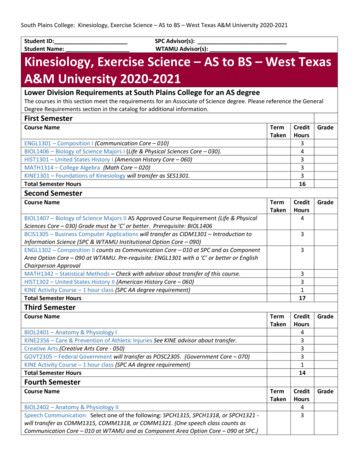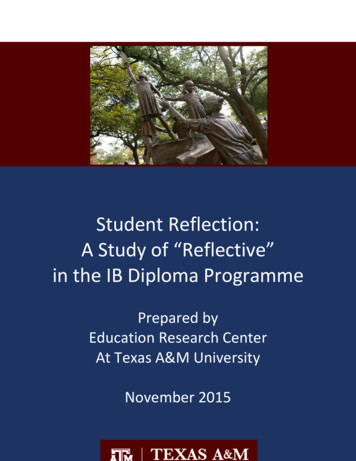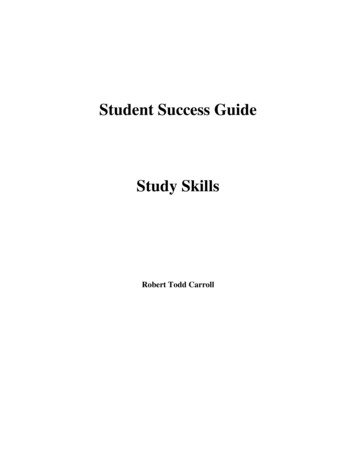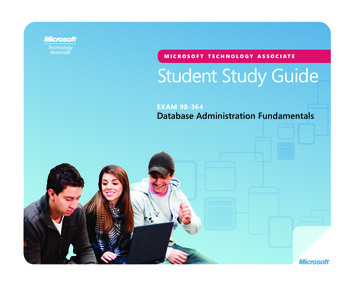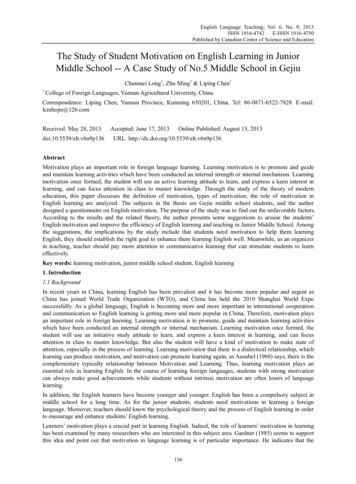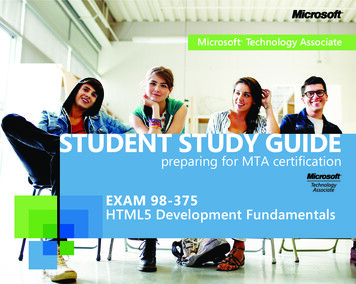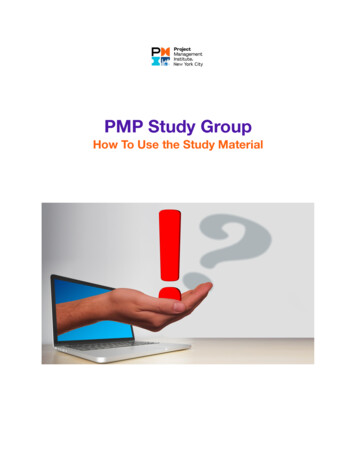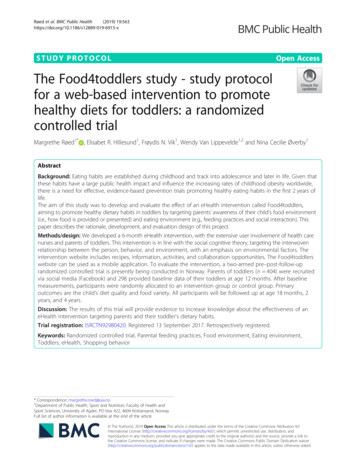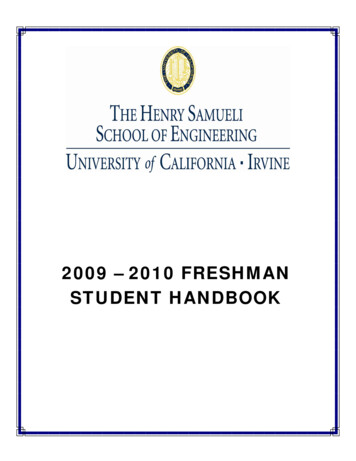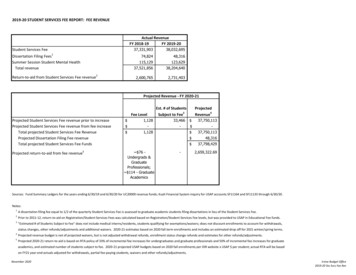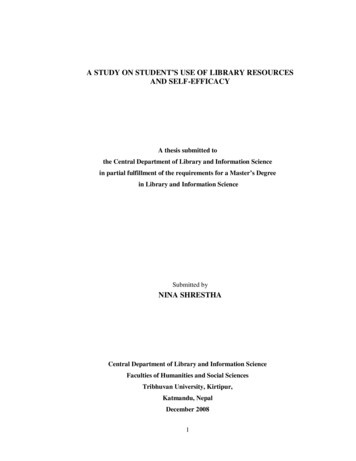
Transcription
A STUDY ON STUDENT’S USE OF LIBRARY RESOURCESAND SELF-EFFICACYA thesis submitted tothe Central Department of Library and Information Sciencein partial fulfillment of the requirements for a Master’s Degreein Library and Information ScienceSubmitted byNINA SHRESTHACentral Department of Library and Information ScienceFaculties of Humanities and Social SciencesTribhuvan University, Kirtipur,Katmandu, NepalDecember 20081
LETTER OF RECOMMENDATIONThis is to certify that Ms. Nina Shrestha has prepared this dissertation entitled"A STUDY ON STUDENTS' USE OF LIBRARY RESOURCES AND SELFEFFICACY", under my supervision and guidance. I recommend this dissertation forfinal approval and acceptance.Date: December 2008.Mrs. Nirmala ShresthaThesis Supervisor2
LETTER OF ACCEPTANCEThe thesis here to attach, entitled "A STUDY ON STUDENTS' USE OFLIBRARY RESOURCES AND SELF-EFFICACY", prepared by Ms. NinaShrestha in partial fulfillment of the requirements for the Master’s Degree in Libraryand Information Science is hereby accepted and approved. .Mrs. Nirmala ShresthaThesis Supervisor .Mr. Bhim Dhoj ShresthaExternal Examiner .Dr. Madhusudan KarkiHead ofDepartment3
ACKNOWLEDGMENTMy sincere note of gratitude to Mrs. Nirmala Shrestha, Former Head of CentralDepartment of Library and Information Science, Tribhuwan University, my supervisorin this study whose comment, insight and suggestions have made this write-up possible.In spite of her busy schedule she has literally encouraged me and without her constantguidance this dissertation would never have come to its present shape.I am equally thankful to all my respected teachers Dr. Madhusudhan Karki, Head ofCentral Department of Library and Information Science, Dr. Mohan Raj Pradhan, Mr.Rudra Prasad Dulal, Mr. Bhim Dhoj Shrestha and Late Mrs. Leela Dahal for theirguidance, encouragement and valuable suggestions. I am indebted for life for theknowledge you all have bestowed upon me. And I would also like to extend myappreciation to all the staff’s of the Department for their assistance in the preparationof the study.My heartfelt thanks to Mr. Dilip Sthapit, Mr. Kamal Kayastha, Mr.Tulshi Bhattaraiand Mrs. Dipta Karmacharya for their co-operation and matchless help.I deeply acknowledge the support given by my sister Abha Shrestha and therespondents of all the three institutions during the study process. Along with them mysincere gratitude to all my staff members of Format Printing House for their supportin typesetting and formatting of the dissertationAt the end my special acknowledgment to my family, my parents Mr. Tilak ManShrestha and Mrs. Saroja Shrestha for their unconditional love and support inwhatever I tried to do. My mother in law Mrs. Shanti Shrestha who always supportedme on my works. My husband Mr. Anil Raj Shrestha for always being there for meand encouraging me while I tend to give up. Lastly I am thankful to my daughtersAvantika and Ananya for understanding me and putting up with my snappiness.Nina ShresthaDecember 20084
ABSTRACTThis study has been undertaken to determine the "Students use of the libraryresources and self-efficacy". This study has tried to find out the information seekingbehavior of the graduate level students andtheir knowledge about the libraryresources and services made available to them. And how their familiarity with theresources and technology develops self-efficacy.The study has tried to find out how the integration of the Internet has affected theinformation searching habit on students.The study has collected empirical data on the information searching behavior of thestudents of the three respective colleges taken under study they are ThapathaliCollege, NCCS(National College of Computer Science) and Kathmandu University.These data has been gathered from 25% of the actually targeted group of study.Questionnaire method has been obtained to collect primary data from the 200 fulltime students of which 127 has been returned which is the exact number ofquestionnaire tabulated for the study.After tabulating and analyzing the data the findings of the study indicated thatstudents are most in the need of intervention as they often come to collegeunprepared. The guidance in the use of library resources and services is necessary tohelp students meet some of the information requirements. It is also found that librarybooks, e-journals and Internet are the most popular source of information for thecourse work and research and the place of Google in the student’s informationbehavior is prominent and positively co-related to use of traditional library resources.The study shows that in today’s fast paced world the desire for expediency haspromoted students to place a premium on information that can be found easily andquickly. To this end, many students limit their search to electronic resources,choosing format over substance and convenience over accuracy. In particular relianceon the world wide web as a primary and often sole research tool has impacted the5
quality and rigor of students projects and reduced students familiarity with moretraditional print resources and bibliographical databases in their college librarycollection.Internet has rapidly become one of the most powerful global sources of wide range ofinformation presenting many possibilities for the efficient and unlimiteddissemination of information. It has contributed positively in enhancing the searcheffectiveness. Which has lead to giving students psychological boost and problemsolving ability. The newfound confidence due to the easily accessible informationresources has upgraded the learning ways among them. Students have become morecompetent and confident about what they could achieve in the given situations andknowledgeable about the ways that leads to the achievement.With the popularity of the electronic resources as the major information sources thestudy has also found that all the libraries is automated with some having their ownonline catalogue system with subscription to electronic journal sites and bibliographicindexes. Even if the library did not have various electronic resources they gaveInternet services through computer labs and online catalogue. But without properknowledge of accessing the information sources both electronic or print students arevulnerable to the overloaded information and was not seen so much keen on using thelibrary’s electronic resources they preferred internet resources as its interface is easyto use and they could get unlimited information on the subjects.Proper guidance and lack of professional person along with the inadequate collectionin the material as well as insufficient networking computers has been the maindrawbacks on students exploring the resources. For them to be more interestedtowards libraries librarians along with the faculty members need to work together ineducating them about the services and resources that is available and library shouldalso work towards networking with other libraries so that it could provide better rangeof materials in given subject.In this study even though students are drawn to information sources that allow them tocomplete their research in “the easiest least painful way” the large percent of studentsare still motivated to learn about accessing their present library resources. With such a6
strong bias among students towards using the web as their primary research tool,library instruction should be considered a crucial means of introducing students toprint resources of the library beside the web. Numerous studies have shown thatpositive change in student’s research skills and knowledge of the library and itsresources after library instruction. This study has also tried to point towards thataspect of the library where it could educate its users by giving orientation so they canbecome an accurate searcher and make use of the right information at the right time.Nina Shrestha7
DEDICATIONThis thesis is dedicatedto noor of my life Avantika and AnanyaAndTo my family8
PREFACELibrary has always been described as the heart of the university. It has been called thebrain of the academic body. The scholar's workshop etc. Library has become soimportant that renowned scholars judged the quality of education by the quality oflibrary service in the university. But in today’s scenario the position of the library inthe academic institution does not seem to be the same. With the development oftechnology, in particular information and communication technologies morecomprehensive relevant and easily searchable subject directories and search enginelike (e.g. Yahoo and Google) and ubiquity of the web have resulted in a generation ofstudents who now perceive the Internet as the most familiar, convenient and expedientsource of information.Chapter One of this thesis deals about the background of the study, statement of theproblem, objective, scope and limitation of the study, significance of the study,definition of the terms and organization of the study. The second chapter deals withthe literature review on the students resources using habits and most frequently usedresources by the students while preparing for their assignments and project work. Thethird chapter deals with the focus of the study on why it is necessary to know aboutthe resources using pattern among the students and what aspects encourages anddiscourages the users to use library resources and why are they more inclined towardselectronic resources. The fourth chapter is about research methodology. The researchwas done by structured and closed type questionnaire and observation method. Thefifth chapter deals with the analysis and presentation of collected data. While the sixthchapter deals with the summary, conclusion and recommendations of the study.The rapid growth and fast changing environment of the Internet has left manyinformation providers and users struggling to keep up-to-date with information. Thisstudy sought to establish the information needs of the graduate students and furthersought to understand the impact of the introduction of new technology on users’information-seeking behaviour.9
It is hoped that this study would help libraries, authorities and faculties get betterknowledge about the information needs of the user group to be served. And meet theexpected demands of the users by developing new pedagogy designed to instructstudents in library usage and provide them with successful exploration of libraryresources.December, 2008Nina Shrestha10
CATALOGS OF THESISShelf List CardD028.8Sh84sShrestha, NinaA study on students use of library resources and selfefficacy / Nina Shrestha. – Kathmandu: Central Departmentof Library and information Science, 2008.01xix, 113p. : ill., tables; 30cm.Dissertation: Masters' Degree of Library and InformationScience from CDLISc1. Library resources-Usage 2. Self -Confidence I. TitleMain CardD028.8Sh84sShrestha, NinaA study on students use of library resources and selfefficacy / Nina shrestha. – Kathmandu: Central Departmentof Library and information Science, 2008.xix, 113p. : ill., tables; 30cm.Dissertation: Masters' Degree of Library and InformationScience from CDLISc1. Library resources-Usage 2. Self- Confidence I. Title11
Subject added cardD028.8Sh84sLIBRARY RESOURCES-USAGEShrestha, NinaA study on students use of library resources and self –efficacy / Nina Shrestha. – Kathmandu: CentralDepartment of Library and information Science, 2008xix, 113p. : ill., tables; 30cm.Dissertation: Masters' Degree of Library and InformationScience from CDLIScSubject added cardD028.8Sh84sSELF-CONFIDENCEShrestha, NinaA study on students use of library resources and self –efficacy / Nina Shrestha. – Kathmandu: Central Departmentof Library and information Science, 2008xix, 113p. : ill., tables; 30cm.Dissertation: Masters' Degree of Library and InformationScience from CDLISc12
Title added cardD028.8Sh84sA study on students use of library resources and self –efficacyShrestha, NinaA study on students use of library resources and self –efficacy / Nina Shrestha. – Kathmandu: CentralDepartment of Library and information Science, 2008xix, 113p. : ill., tables; 30cm.Dissertation: Masters' Degree of Library and InformationScience from CDLISc13
TABLE OF CONTENTSRecommendation by guide teacherApproval Letter from DepartmentAcknowledgementAbstractDedication pagePrefaceCatalog of the thesisTable of ContentsList of tablesList of figuresList of appendicesList of Acronyms and IXIXChapter1.2.3.INTRODUCTION1-171.1. Introduction of the study1.2. Statement of the problem1.3. Objectives of the study1.4. Scope and limitation of the study1.5. Significance of the study1.6. Definition of terms1.7. Organization of the study1111213131417REVIEW OF LITERATURE18-372.1 Pre Internet era2.2 Internet age2.3 Use of electronic information2.4 Self efficacy24252634FOCUS OF THE STUDY38-573.1.Achieving information literacy3.1.2 Self efficacy and its importance for40information literacy and lifelong learning423.2. User education and library use3.3 Library use3.4 Students and their information behaviour44454514
4.5.3.5 Library Services3.6 Frequency of Computer use3.7 Influence of electronic resource3.8 Profile of the College3.8.1 Kathmandu University3.8.2 National college of computer Studies3.8.3 Thapathali Campus47484850505456RESERCH METHODOLOGY58-604.1. Research design4.2. Source of Data4.3 Population4.4. Sampling procedure4.5 Data collection procedure4.6. Data analysis procedure585858595960ANALYSIS AND PRESENTATIONS61-935.1. Distribution of questionnaire5.2. Computer Ownership5.3. Access to computer6163645.4. Access to computer since school5.5. Internet accessing frequency5.6. Purpose for accessing the internet5.7. Use of Search engines5.8. Frequency of using Search engines5.9. Popular Search engines among students5.10. Frequency of Library visit5.11. Purpose of visiting Library5.12. Students activity in Library5.13. Library orientation5.14. Use of Library resources5.15. Availability of electronic resources6566676869707172747576775.16. Effective use of resources5.17. User member of information centers5.18. Types of information that users generally seek atinformation centers5.19. Motivation factor or visiting library5.20. Accessing electronic resources787915808182
6.5.21. Effective retrieval of information via electronic resources5.22. Most preferred source of obtaining information5.23. Source of information5.24. Effectiveness of internet5.25. Information mostly retrived5.26. Difference between information retrieved5.27. Motivation to learn about library resources5.28. Information retrieving ability5.29.Students satisfaction with obtaining information5.30. Obstacles on reaching to information83848587888990919293SUMMARY, CONCLUSIONS ANDRECOMMENDATIONS94-1016.1. Summary of Findings6.2. Conclusion6.3 Recommendation9498100BIBLIOGRAPHY102-107APPENDICES 1108-111APPENDICES 211216
LIST OF TABLES:Table Number 1 Questionnaires distributed and returned by the students.Table Number 2 Computer ownership by the studentsTable Number 3 Access to computerTable Number 4 Computing knowledge since schoolTable Number 5 Internet Accessing FrequencyTable Number 6 Purpose for accessing the InternetTable Number 7 Use of Search EnginesTable Number 8 Frequency of using search enginesTable Number 9 Popular search engines among the studentsTable Number 10 Frequency of library visit by the studentsTable Number 11 Purpose of visiting the libraryTable Number 12 Students activity in the libraryTable Number 13 Users EducationTable Number 14 Use of library resourcesTable Number 15 Availability of Electronic ResourcesTable Number 16 Search EffectivenessTable Number 17 Users as members of other information centersTable Number 18 Types of information that users seek in other information centersTable Number 19 Motivation to go to the libraryTable Number 20 Comfort level while accessing electronic resources of collegelibrariesTable Number 21 Effective retrieval of informationTable Number 22 Preferred source of obtaining informationTable Number 23 Information source about libraryTable Number 24 Effectiveness in finding information via InternetTable Number 25 Mostly used resources for searching informationTable Number 26 Differences in information retrieved from two sourcesTable Number 27 Students interest in learning about library resourcesTable Number 28 Information retrieving abilityTable Number 29 Students satisfaction with obtaining informationTable Number 30 Obstacles on reaching to information17
LIST OF FIGURESFigure Number 1Questionnaire distributed and not returnedFigure Number 2Computer ownership by studentsFigure Number 3Access to ComputerFigure Number 4Internet accessing frequencyFigure Number 5Purpose for accessing InternetFigure Number 6Search engine UsersFigure Number 7Popular search enginesFigure Number 8Library visiting frequencyFigure Number 9Purpose for using libraryFigure Number 10 Activities in the libraryFigure Number 11 Users educationFigure Number 12 Use of library resourcesFigure Number 13 Availability of Electronic ResourcesFigure Number 14 Effective use of ResourcesFigure Number 15 Users as members of other information centersFigure Number 16 Types of information that users seekFigure Number 17 Preffered source of informationFigure Number 18 Users source of knowledge about libraryFigure Number 19 Internet as major sourceFigure Number 20 Most used resources for finding informationFigure Number 21 Interest level in learning about library resourcesFigure Number 22 Obstacles in reaching towards information18
LIST OF APPENDICSAppendices 1: Questionnaires distributed to studentsAppendices 2: Bio Data19
LIST OF ACRONYMSAACR2 :Anglo American Cataloguing Rules 2ACRL:Association of College and Research LibrariesB.E :Bachelor of EngineeringBIM:Bachelor of information and managementCDS/ISIS:Computerized Documentation System/Integrated Setfor Information SystemDDC schemes: Dewey Decimal Classification SchemesEIS :Electronic Information SourcesER:Electronic ResourcesICT:Information and Communication technologiesIT:Information TechnologyK.U:Kathmandu UniversityNCCS :National College of Computer ScienceOPAC:Online Public Access CatalogueP.C:Personal ComputerRSS:Rastriya Samachar SamitiT.C:Thapathali CampusW.W.W:World Wide Web20
21
CHAPTER ONEINTRODUCTION1.1 Introduction of the studyEducation is the key factor in the development and advancement of a society. Eachindividual in a country should be considered as an asset because it is due to the overallcontribution of human resources that a nation can progress and advance. To integrateeach individual in the process of development and advancement of the nation, suitableeducation and training is very important. Since education and training of an individualis a life long process every nation must be aware of this fact, if proper directions areto be given to its people.10To ensure that people get a life long education libraries should be made accessible andlibrary services should be made available at all places, to all sections of the society.The human need for information is unlimited. People seek information from differentsources and formats for undertaking a variety of jobs and tasks. They use informationfor decision making, discovering new phenomena, developing new techniques andtechnologies, and improving existing knowledge and theories. Information also playsa vital role in shaping human thinking and character building, communication, and theteaching process. Tremendous growth in knowledge, technological advancements andrapid changes in the modern world have led to an increased awareness of theimportance of information in all aspects of life.Academic institutions play a key role in society by preparing future generations to usethe acquired knowledge to fulfil their responsibilities more effectively. The librariesof these institutions serve a variety of users such as students, faculty, administratorsand staff with diverse information needs. These libraries collect a variety ofinformation sources and offer various services for supporting instructional, research10Malhan,Vir Inder and Gupta,Urmila ”New Education policy and development of School libraries inIndia” in “Herald of Library Science” vol.28, no.2, jan-april1989. p.33.22
and learning activities. Hence, the importance of libraries in academic institutions isconsiderable and they are often viewed as a nucleus of academic activity.11Today’s library is powerhouse where information is stored, generated and transferredto fulfill the users need. For the optimum use of this library its users should also haveknowledge to access its resources to their full benefit making every search effective.But still the information searching strategies shows that the user’s searching behavioras being subject specific and most users pick what they perceive as important word inan assigned topic and they use it to search for the needed information.The library must have a through knowledge of the users needs. Without knowing theinformation needs of its users it is difficult to provide effective and efficient service tothem. It is also impossible to collect the documents without knowing the informationneeds of its readers. Normally all libraries activities are designed to develop a systembased on a string service to be provided to the users up to their at most satisfaction.The information service is provided to meet the needs of users. Information servicesinclude personal assistance provided to users in pursuit of information. The characterand extent of such services will vary with kind of library or information centers, thetype of users. The information services are to be developed not only to meet userneeds and to improve present services but also to anticipate users' needs in the future.The effectiveness of any information service depends upon the satisfaction of theinformation needs of its users. The efficiency of an information service can bemeasured only by the degree to which its resources are utilized.12Most students finish their education without even visiting the libraries or using libraryresources. Though library is called the integral part of academic library it has notbecome fully an essential part of educational system and the learning process.Especially on the student of undergraduates level they generally start their searcheswith an encyclopedia rather than card catalog.11Majid,Shaheen and Abdoulaye,kaba”Use of the Internet for reference services in MalaysianAcademic libraries” in “online information review” vol.24, no.5, 2000.12Shrestha, Nirmala. "Survey Report on Secondary School Libraries in Kathmandu Valleywith special referenceto Science and Technology”.- Kathmandu: National Council for Science & Technology, 1998. .p.43.23
Users have a distorted view of their knowledge of library skill. Realizing this malicesituation it is necessary for students at all level to be given library-user education sothat they won’t waste their valuable learning time and without assistant also studentcan make an effective use of library resources. The overall objective should be tomake the student appreciate the value of information and to impart library skills andstudy skills.Information sources are available in various forms such as journal as journal articles,research paper, books, magazines film and audio/video recording plus the data storedin computer as well as in compact disks. As a growth in literature its volume, varietyand complexity has put severe constraints of the users search for their neededinformation. The complexity of electronic resources also led to the tedious search forevery unsatisfactory search, which further discouraged the students in using libraryresources.In today’s scenario more students surf the Internet for information then going throughthe library resources, as it is less complicated and readily available. Still student whoare regular uses of the library know that libraries have resources that are morecomprehensive and scholarly then most web sites provide. Which also are not freelyavailable or may not be online at all. Libraries of academic field do have subscriptionto e-journals that could give access to good articles in the needed studies but are notavailable through other search engines. For these whole mass of Gen X as they calledthem could be motivated towards using library resources which could be possible onlyby shifting the education system from teacher centered learning to student centeredlearning, from a subject based to knowledge based learning.It is in college that a student becomes aware of the library resources where somestudent may show interest in learning and using library resources both electronic andprint whereas some may not find it necessary to find specialized resources for theirpapers.This difference in approach could be the student attitude towards technology. Itevolves as the student’s familiarity with the technology increases. Student new to aparticular technology may initially exhibit some concern about the role of technology24
in their learning process. There are various factors that affect the use of libraryresources by the student and one among them is self-efficacy.13Students may not have been exposed to library resources, or not be aware of whichresources a library might have, or how to make use of them. Therefore this study is tounderstand what characteristics will make one student branch out and explore libraryresources while another might not.14Libraries are termed as treasure of knowledge it house information available in avariety of documentary forms such as journal articles, research and technical reports,conference papers, standards, patents, dissertation, survey data etc. According to thenature of information content these are categorized as primary sources. Primarysources are that which embody the information in original and nascent form. Librariesalso provides secondary source of information that guides users to the primarydocuments or more so they organize the primary literature in convenient formdocuments like indexes, bibliographies and abstracts. Other than these one more typeof sources termed as reference sources also exist which are basically books that arereferred to for a definite piece of information like dictionaries, encyclopedias andhandbook All these forms of sources are part of the library resources. In thisinformation age along with these traditional forms of resources a new form ofresources are also introduced in libraries they are CD-ROM, online journals, OpticalDiscs, DVD and Internet.Students today are web savvy they normally prefer the fastest way that would lead tosatisfactory results when studying like going for the electronic library resources ifthey have or rather searching through the Internet from the library or from homewherever they have access from or also making use of the other information centersthat have access to electronic information sources.A vast and growing amount of information available through electronic informationresources and its accessibility has given students an opportunity to enhance their13Waldman,Micheal “Freshman’s use of library electronic resources and self efficacy” in “InformationResearch”.-New York, vol8, no.2, 2003.14Indira Gandhi National Open University School of social science “Customised Organisatin ofInformation Sources” IGNOU, 2002 p.17.25
academic performance. It also provides an atmosphere that encourages sharing ofknowledge in the creative process. The advancement in technology and tremendousgrowth in information have made learning much easier it totally depends upon theindividual how he/ she makes use of it and implement in their learning process. It is astudent’s own perception that leads to incapable performance. Students with a strongsense of competence approach difficult tasks as challenges to be mastered rather thanas threat to be avoided. Their belief in their ability to succeed in specific situationsplay a major role in how they approach goals, tasks and challenges.In today’s world where technology has become an integral part of higher education ithas highly become influential in student’s attitudes towards learning. Libraries andexpectations from libraries have changed a lot in recent years. Traditionally librarieshave evaluated themselves in terms of their size for example number of volumes,there inputs such as number of transactions and their outputs, such as circulation.These measures are not necessarily measures of quality of service. Recently anincreasing demand for greater accountability in higher education has created ademand for the academic library to show objectively how well it is doing and theextent to which student benefit from library services. 15Among various types of library, academic library is one. Academic library is anintegral part of an institution of higher education. A library in school, college,university and all other institution of higher learning is known as Academic Library.The fundamental role of academic library is educational that may give a dynamicinstrument of education. It provides facilities to students, faculty members/teachers,schools, researchers, etc. to enhance their knowledge.The academic library is divided in three basic categories i.e. school library, collegelibrary, university library. The school, college and university are the institutionswhich impart formal education to the students: These academic institutions aresupposed to have rich libraries to feed the students, teachers and research scholars inmeeting their day to day needs related to study and research and to supplement theclass room teaching. The academic library is always linked with the objectives of15Morgan, Steve “Academic libraries” in “Library Reviews” vol.49, no.9, 2000. p.448-
of Library and information Science, 2008. xix, 113p. : ill., tables; 30cm. Dissertation: Masters' Degree of Library and Information Science from CDLISc 1. Library resources-Usage 2. Self -Confidence I. Title Main Card D 028.8 Sh84s Shrestha, Nina A study on students use of libr

